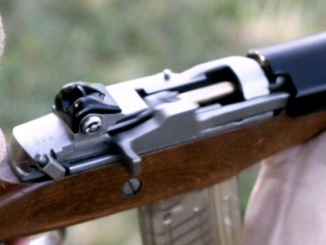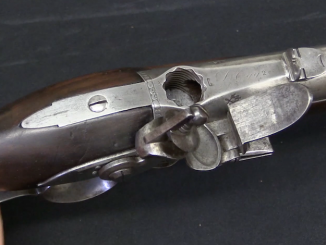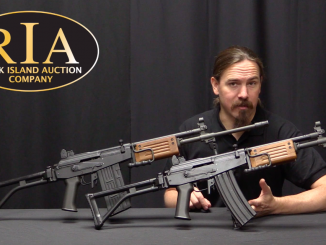Isaac Newton Lewis is best known for the Lewis light machine gun, but that was not his only foray into firearms design. He also patented two different types of handguns – one gas operated and this short recoil design. Very little information about this pistol is available, although it was apparently tested (and rejected) by the French military in the early 1920s. It is quite a bulky gun, although with that bulk does come a 15-round magazine capacity, and a rather clever unlocking system.
Related Articles

Select-fire Rifles
Ruger AC-556 at the Range: How Does it Compare to the M16?
Yesterday we took a look at the internals of Ruger’s select-fire AC-556, and today we have it out at the range. The main question for me was, how does it compare to the M16/AR-15? And […]

Flintlock
Durs Egg Ferguson – A Trials Breechloader From 1776
This Ferguson rifle sold for $96,000. Captain Patrick Ferguson was a British officer who designed and patented a breechloading rifle in 1776, which would actually see service in the American Revolution at the Battle of […]

Semiauto Rifles
The Israeli Galil
These rifles are selling at Rock Island on November 30 and December 1, 2018 – the 5.56mm Model 392 brought $4,600 and 7.62mm Model 323S brought $3,738. The Galil was the result of a program to […]

With a plastic receiver and fire select lever, would be a good nominate for PDW today. It seems, Mr Lewis is an admirer of Herr Mannlicher since gun’s configuration; Removable lockwork housing, Locking block with a slot permitting hammer pass, All recoiling parts remaining within the receiver and separate return spring for barrel, all follow Mannlicher 1896 pistol construction. Unlocking seems stronger however.
Yeah, about that… How about some deja vu?
https://www.bt-ag.ch/shop/eng/bt-usw/bt-universal-service-weapon–usw-a1-kal-9-x-19-bt-430001
https://www.google.com/patents/US1430662?dq=ininventor:%22Lewis+Isaac+N%22&hl=en&sa=X&ved=0ahUKEwit5_P42uDUAhUI2oMKHdYxBkkQ6AEINDAC
Automatic pistol patent
US 1430662 A
Thanks for the patent. But it does not describe this short recoil vertically swinging lock handgun. Seemingly, it belongs another pistol with gas operation getting use of gas trap action and turning bolt lock.
If the future of handguns includes integration of red-dot sights, than some design elements of this Lewis pistol might be relevant. Better to fix a relatively delicate optical sight to a nonmoving upper receiver than to a receprocating slide.
“red-dot sights”
Assuming that this mean REFLEX sights, I would suggest solution used in Margolin MCM automatic pistol – rear sights sitting on “bridge”, unmoving in relation to frame.
Shouldn’t there be a back up iron sight as well? If your reflex sight dies and there are no iron sights on the gun, you may as well spray and pray that the intended recipient of your bullets is reduced to hamburger. Did I mess up?
“Shouldn’t there be a back up iron sight as well?”
Then I propose groove in slide sights, as seen for example at Bayard Mle. 1923, see 3rd photo from top here:
http://zonwar.ru/pistolet/Bayard-1923.html
Some interesting ideas, there.
“tested (and rejected) by the French military in the early 1920s”
Interesting. Have anyone sources describing French automatic pistol trials in inter-war period? I known that Le Français «Type Armée» in 9×20 mm SR Browning Long was tested, though I don’t know full description of all trials and competitors. Query in wikipedia: https://fr.wikipedia.org/wiki/Le_Français_6,35_mm/7,65_mm/Modèle_Armée
states it was tested between 1928 and 1933, but not adopted. 4000 were produced between 1928 and 1939 [but for whom? and what was fate of that automatic pistols? was it available at commercial French market? maybe it was exported?]. Since 1932 it has radiator on barrel [if I understand it correctly; why it was added? is it even possible to fire such fast from that automatic pistol to overheat it /cause cartridge to cook-off that is activate only by thermal energy, without striking primer/ if it has not that radiator?]
According to http://armesfrancaises.free.fr/PA%20LE%20FRANCAIS%20type%20ARMEE.html the pistol was sold commercially and even used by some French officers in 1940.
I would guess the cooling fins were added in order keep the chamber cooler, so that the cartridge in the chamber, either after a malfunction or at the end of shooting practice, could be more easily removed without a tool. Clearing the chamber was already the biggest shortcoming of the design, so the designers probably thought that at least you should be able to do it without burning your fingers or carrying a stick for the job.
“carrying a stick for the job.”
I overlooked that bug/feature* of that design, with its peculiar loading procedure (shove magazine, put manually cartridge in chamber, close barrel), might be probable be acceptable in vest pocket automatic pistol in early 20th century, but seems to be great disadvantage in military applications. Anyway get this problem solved, but as late as 1950:
http://modernfirearms.net/handguns/hg/fr/le-francais-e.html
(see 5th image from top), why they don’t upgrade it earlier – I don’t know.
*delete as appropriate
I would guess that the Armee model relied on a fairly heavy recoil spring to delay the opening of the breech. A heavy spring would have racking the slide very difficult. Le Français has an exposed barrel, which means that the slide is shorter and probably lighter than on pistols which have a full length slide starting from the end of the barrel, such as the FN M1903.
Le Français was not designed to be a military sidearm. The Armee model was an opportunistic bid from the manufacturer, which could be made without developing a completely new pistol. I remember reading somewhere (sorry, can’t remember where) that the 9mm Browning Long cartridge was something the French Army was considering after WW1 and the Le Français design could be enlarged for it.
Who knew that this would become a series. ^__^
https://www.forgottenweapons.com/lewis-gas-operated-pistol-video/
As strange as it sounds, my family had at least the shell of one of these until the early 1970’s. The clip, trigger, barrel and inner workings were all missing, but we had the grip, the screw in barrel guide, and the sliding receiver, all held together by a scrap of wood that had been wedged in to keep them (sort of), together. The 1930’s were tough and I suspect a family member must have picked it up from someone trying to raise some cash. My brothers and I played with it for years, but I thought it was just some kind of very heavy cold war space toy. True to your observation, there were no markings on the one we had and the barrel guide was clearly not rifled, reinforcing the toy idea. Never realized until I saw your episode that it was a real gun we had been playing with.